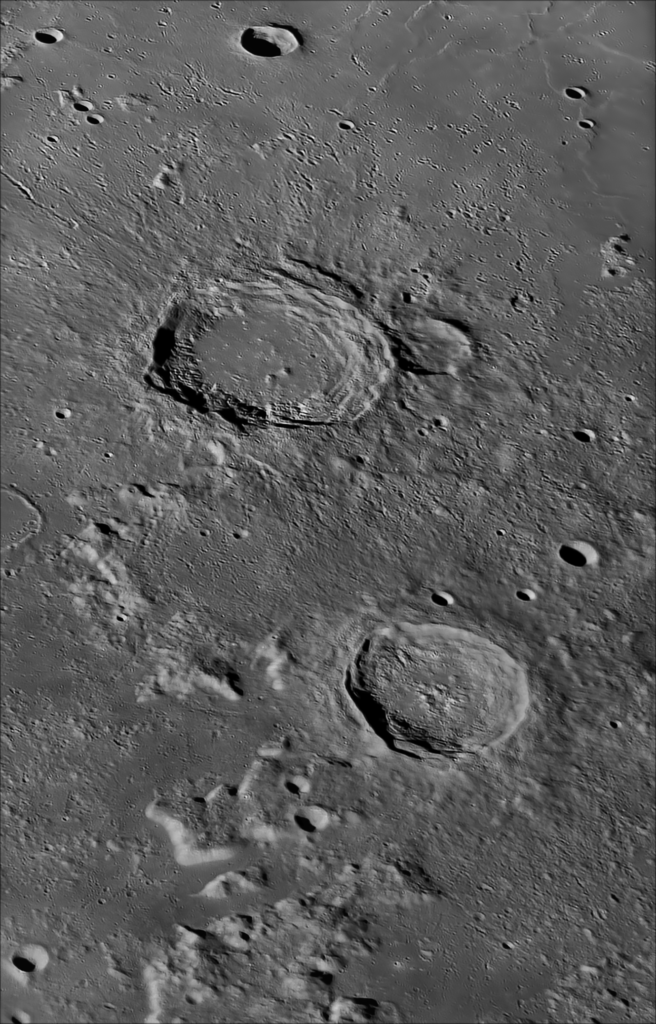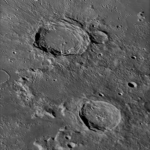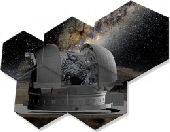Italiano:
Tra le ultime riprese lunari ancora della notte del 18 ottobre scorso, questa che Vi presento ha una risoluzione leggermente migliore per la presenza, in fase di ripresa, di un seeing a tratti più costante (intorno a 6,5-7/10 per mia valutazione, nella “finestra” dell’IR a 685nm).
Questa immagine, in particolare, riguarda la zona dei bei crateri “Aristoteles” ed “Eudoxus”.
“Aristoteles” è un cratere da impatto lunare di 87 km di diametro e profondità 3.4 km, che si trova vicino al bordo meridionale del “Mare Frigoris” e ad est della catena montuosa dei “Montes Alpes”.
Tramite osservazioni del cratere, si è notato che la parete del cratere di Aristotele è leggermente distorta, con una forma leggermente esagonale arrotondata (visibile chiaramente in foto), mentre le pareti interne sono ampie e finemente terrazzate.
I bastioni esterni mostrano una vista generale delle collinette attraverso l’ampia coltre di “ejecta” (frammenti derivanti dall’impatto), mentre il pavimento del cratere è irregolare e coperto da increspature collinari. Aristoteles possiede piccoli picchi centrali, che sono in qualche modo spostati verso sud e il fondo del cratere è ricoperto di uno strato di materiale che seppellisce parzialmente queste sporgenze.
Nell’immediato sud di Aristoteles si trova il cratere leggermente più piccolo Eudoxus e queste due forme formano una coppia distintiva per un osservatore del telescopio. Un arco di montagne tra questi crateri si piega a ovest prima di unirsi ai rispettivi bordi. Il cratere più piccolo “Mitchell” è direttamente attaccato al bordo orientale di Aristoteles.
“Eudoxus” è anch’esso un cratere da impatto lunare (diametro 67 km, profondità 3.35 km) che si trova ad est della punta settentrionale della catena montuosa del Caucaso e a sud del cratere Aristotele, nelle regioni settentrionali della faccia a noi visibile della Luna. A sud di esso si trova la formazione craterica erosa di “Alexander”, mentre il piccolo cratere “Lamèch” si trova a sud-ovest, in mezzo ai Montes Caucasus.
Il bordo di Eudoxus ha una serie di terrazze sulla parete interna e bastioni leggermente usurati attorno all’esterno, esso è mancante di picco centrale, ma ha un gruppo di basse colline intorno al punto medio del fondo del cratere, mentre Il resto del fondo interno è relativamente piano.
Esso ha un sistema a raggiere ed è di conseguenza mappato come parte del Sistema Copernicano.
Grazie per la Vs. attenzione e… alla prossima immagine lunare!
Dettagli tecnici:
Telescopio Astrofaktoria DK20 @ ~ F/19 – Baader FFC Multiplier – Baader IR 685nm filter – GS3-U323S6M-C camera – Seeing 6,5/10 in IR band – sito: Palermo @ my personal Observatory.
English:
Among the last lunar shots of the night of last October 18th, this one I present to you have a slightly better resolution due to the presence, during the imaging session, of a more constant seeing at times (around full 6.5/10 was my valutation), in the “window” of the IR channel @ 685nm).
This image, in particular, concerns the area of ??the beautiful “Aristoteles” and “Eudoxus” craters.
“Aristoteles” is a lunar impact crater of 87 km in diameter and 3.4 km in depth, located near the southern edge of the “Mare Frigoris” and east of the “Montes Alpes” mountain range.
Through observations of the crater, it was noted that the wall of Aristotle’s crater is slightly distorted, with a slightly rounded hexagonal shape (clearly visible in this
image), while the internal walls are large and finely terraced.
The external borders show a general view of the hills through the wide blanket of “ejecta” (fragments deriving from the impact), while the crater floor is irregular and covered by hilly ripples.
Aristoteles has small central peaks, which are somehow moved to the south and the bottom of the crater is covered with a layer of material that partially buries these protrusions.
In the immediate south of Aristoteles is the slightly smaller “Eudoxus” crater and these two forms a distinctive pair for a telescope observer. An arch of mountains between these craters bends to the west before joining their respective edges. The smaller “Mitchell” crater is directly attached to the eastern edge of Aristoteles.
“Eudoxus” is also a lunar impact crater (diameter 67 km, depth 3.35 km) located east of the northern tip of the Caucasus mountain range and south of the Aristotle crater, in the northern regions of the face visible to us of the Moon.
To the south of it, is located the eroded crater formation of “Alexander”, while the small “Lamèch” crater is located to the south-west, in the midst of the Montes Caucasus.
The edge of Eudoxus has a series of terraces on the inner wall and slightly worn bastions around the outside, it is missing a central peak, but has a group of low hills around the midpoint of the bottom of the crater, while the rest of the inner bottom it is relatively flat.
It has a ray system and is therefore mapped as part of the Copernican system.
Thank you for your attention and… See you my next lunar image!
Technical details:
Astrofaktoria Telescope DK20 @ ~ F / 19 – Baader FFC Multiplier – Baader IR 685nm filter – GS3-U323S6M-C camera – Seeing 6,5/10 in IR band – site: Palermo @ my personal Observatory.


